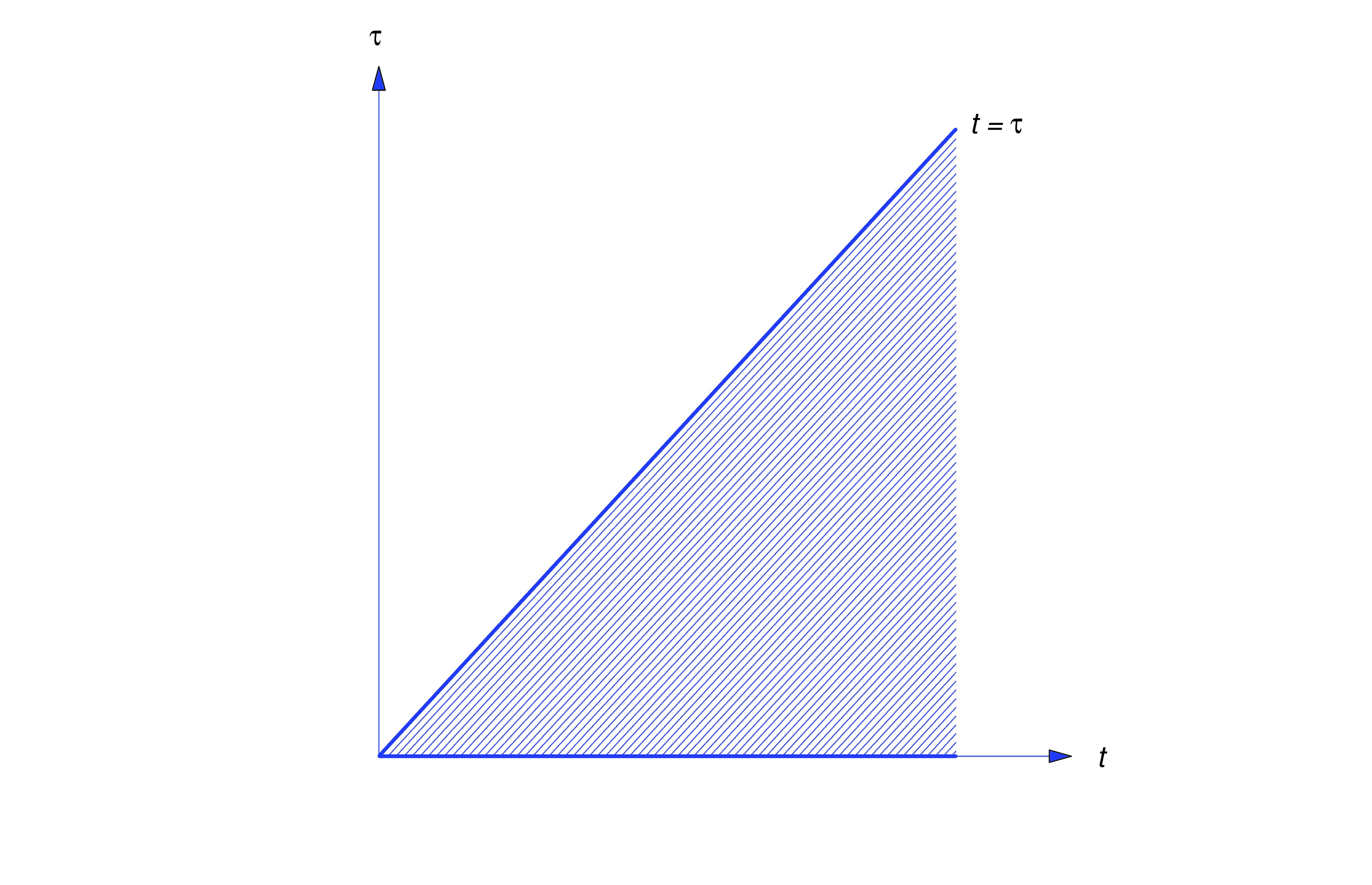We define the convolution of two functions, and discuss its application to computing the inverse Laplace transform of a product.
Convolution
In this section we consider the problem of finding the inverse Laplace transform of a product , where and are the Laplace transforms of known functions and . To motivate our interest in this problem, consider the initial value problem Taking Laplace transforms yields so
whereUntil now haven’t been interested in the factorization indicated in (eq:8.6.1), since we dealt only with differential equations with specific forcing functions. Hence, we could simply do the indicated multiplication in (eq:8.6.1) and use the table of Laplace transforms to find . However, this isn’t possible if we want a formula for in terms of , which may be unspecified.
To motivate the formula for , consider the initial value problem
which we first solve without using the Laplace transform. The solution of the differential equation in (eq:8.6.2) is of the form where Integrating this from to and imposing the initial condition yields ThereforeNow we’ll use the Laplace transform to solve (eq:8.6.2) and compare the result to (eq:8.6.3). Taking Laplace transforms in (eq:8.6.2) yields so which implies that
If we now let , so that then (eq:8.6.3) and (eq:8.6.4) can be written as and respectively. Therefore in this case.This motivates the next definition.
It can be shown that ; that is,
Eqn. (eq:8.6.5) shows that in the special case where . This next theorem states that this is true in general.
A complete proof of the convolution theorem is beyond the scope of this book. However, we’ll assume that has a Laplace transform and verify the conclusion of the theorem in a purely computational way. By the definition of the Laplace transform, This iterated integral equals a double integral over the region shown in the figure below.

Reversing the order of integration yields
However, the substitution shows thatA Formula for the Solution of an Initial Value Problem
The convolution theorem provides a formula for the solution of an initial value problem for a linear constant coefficient second order equation with an unspecified set of initial conditions. The next three examples illustrate this.
Evaluating Convolution Integrals
We’ll say that an integral of the form is a convolution integral. The convolution theorem provides a convenient way to evaluate convolution integrals.
Volterra Integral Equations
An equation of the form
is a Volterra integral equation. Here and are given functions and is unknown. Since the integral on the right is a convolution integral, the convolution theorem provides a convenient formula for solving (eq:8.6.11). Taking Laplace transforms in (eq:8.6.11) yields and solving this for yields We then obtain the solution of (eq:8.6.11) as .Transfer Functions
The next theorem presents a formula for the solution of the general initial value problem where we assume for simplicity that is continuous on and that exists. It can also be shown that the formula is valid under much weaker conditions on .
- Proof
- Taking Laplace transforms in (eq:8.6.13) yields
where
Hence,
with
and
Taking Laplace transforms in (eq:8.6.15) and (eq:8.6.16) shows that Therefore and
Hence, (eq:8.6.20) can be rewritten as Substituting this into (eq:8.6.18) yields Taking inverse transforms and invoking the convolution theorem yields (eq:8.6.14). Finally, (eq:8.6.19) and (eq:8.6.21) imply (eq:8.6.17).
It is useful to note from (eq:8.6.14) that is of the form where depends on the initial conditions and is independent of the forcing function, while depends on the forcing function and is independent of the initial conditions. If the zeros of the characteristic polynomial of the complementary equation have negative real parts, then and both approach zero as , so for any choice of initial conditions. Moreover, the value of is essentially independent of the values of for large , since . In this case we say that and are transient and steady state components, respectively, of the solution of (eq:8.6.13). These definitions apply to the initial value problem of Example example:8.6.4, where the zeros of are . From (eq:8.6.10), we see that the solution of the general initial value problem of Example example:8.6.4 is , where is the transient component of the solution and is the steady state component. The definitions don’t apply to the initial value problems considered in Examples example:8.6.2 and example:8.6.3, since the zeros of the characteristic polynomials in these two examples don’t have negative real parts.
In physical applications where the input and the output of a device are related by (eq:8.6.13), the zeros of the characteristic polynomial usually do have negative real parts. Then is called the transfer function of the device. Since we see that is the ratio of the transform of the steady state output to the transform of the input.
Because of the form of is sometimes called the weighting function of the device, since it assigns weights to past values of the input . It is also called the impulse response of the device, for reasons discussed in the next section.
Text Source
Trench, William F., ”Elementary Differential Equations” (2013). Faculty Authored and Edited Books & CDs. 8. (CC-BY-NC-SA)